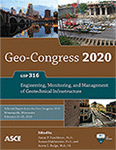Geo-Congress 2020
Influence of Anisotropic Permeability on Slope Stability Analysis of an Earthen Dam during Rapid Drawdown
Publication: Geo-Congress 2020: Engineering, Monitoring, and Management of Geotechnical Infrastructure (GSP 316)
ABSTRACT
The operation of dams at times requires a sudden decrease in the existing reservoir level. This abrupt change in the upstream water level, known as rapid drawdown, results in the development of unbalanced forces and occasionally causes catastrophic failure of the upstream shell. The drawdown-induced slope stability analyses are typically performed assuming that geomaterials used to build the dam exhibit isotropic permeability; even though, in reality, the geomaterials mostly exhibit anisotropic properties. The principal objective of this study is to comprehend the impact of anisotropic permeability on the drawdown-induced stability analysis of earthen dams and assess the impact of erroneously assuming isotropic permeability properties for numerical analyses. The influence of dam geometry, rate of drawdown, and depth of reservoir water before drawdown were also studied. The results of this research study highlight that the assumption of isotropic permeability inevitably leads to erroneous estimation of deformations incurred during drawdown. The extent of error was observed to increase with an increase in the dam slope and drawdown velocity.
Get full access to this article
View all available purchase options and get full access to this chapter.
ACKNOWLEDGEMENT
The authors would like to acknowledge the PLAXIS-2D support team for providing general support and additional soil modules used in the analysis.
REFERENCES
Alpan, I. (1970). “The geotechnical properties of soils.” Earth-Science Reviews, Elsevier, 6(1), 5–49.
Berilgen, M. M. (2007). “Investigation of stability of slopes under drawdown conditions.” Computers and Geotechnics, Elsevier, 34(2), 81–91.
Boulanger, R. W., and Montgomery, J. (2016). “Nonlinear deformation analyses of an embankment dam on a spatially variable liquefiable deposit.” Soil Dynamics and Earthquake Engineering, 91, 222–233.
Boulanger, R. W., and Ziotopoulou, K. (2015). PM4Sand (Version 3): A sand plasticity model for earthquake engineering applications. Center for Geotechnical Modeling Report No. UCD/CGM-15/01, Department of Civil and Environmental Engineering, University of California, Davis, California.
Chakraborty, S., Das, J. T., Banerjee, A., and Puppala, A. J. (2017). "Effect of erroneous estimation of small strain shear moduli on seismic response of an earth dam." In Indian Geotechnical Conference. Guwahati, India (pp. 1-5).
Chakraborty, S., Das, J. T., Puppala, A. J., and Banerjee, A. (2019). "Natural frequency of earthen dams at different induced strain levels." Engineering Geology, 248, 330-345.
Chapuis, R. P., Gill, D. E., and Baass, K. (1989). “Laboratory permeability tests on sand: influence of the compaction method on anisotropy.” Canadian Geotechnical Journal, 26(4), 614–622.
Chopra., A.K. (1967). “Earthquake response of earth dams.” Journal of the Soil Mechanics and Foundations Division, 93(2), 65–81.
Clavaud, J.B., Maineult, A., Zamora, M., Rasolofosaon, P., and Schlitter, C. (2008). “Permeability anisotropy and its relations with porous medium structure.” Journal of Geophysical Research, 113(B1), B01202.
Desai, C. S. (1972). “Seepage analysis of earth banks under drawdown.” Journal of Soil Mechanics & Foundations Div, 98(Sm 11), 1143-62.
Duncan, J. M., Wright, S. G., and Wong, K. S. (1990). “Slope stability during rapid drawdown.” Proceedings of the H. Bolton Seed Memorial Symposium, BiTech Publishers Ltd, Vancouver, B.C., Canada, 2, 253–272.
Duncan, J. M. (1996). “State of the Art: Limit Equilibrium and Finite-Element Analysis of Slopes.” Journal of Geotechnical Engineering, American Society of Civil Engineers, 122(7), 577–596.
Jamiolkowski, M., Ladd, C.C., Germaine, J.T., and Lancellotta, R. (1985). “New developments in field and laboratory testing of soils.” Proceedings of the 11th International Conference on Soil Mechanics and Foundation Engineering, San Francisco, California, 57–153.
Lane, P. A., and Griffiths, D. V. (2000). “Assessment of Stability of Slopes under Drawdown Conditions.” Journal of Geotechnical and Geoenvironmental Engineering, 126(5), 443–450.
Mayne, P. W. (2007). Cone penetration testing: a synthesis of highway practice. NCHRP Synthesis Report 368, Transportation Research Board, Washington DC.
Mitchell, J. K., Guzikowski, F., and Villet, W. C. B. (1978). The Measurement of Soil Properties in situ: Present Methods & Their Applicability and Potential. Berkley, California.
Moregenstern, N. (1963). “Stability charts for earth slopes during rapid drawdown.” Géotechnique, Thomas Telford Ltd, 13(2), 121–131.
Pinyol, N. M., Alonso, E. E., and Olivella, S. (2008). “Rapid drawdown in slopes and embankments.” Water Resources Research, 44(5), 0–03.
Robertson, P. K., Sully, J. P., Woeller, D. J., Lunne, T., Powell, J. J. M., and Gillespie, D. G. (1992). “Estimating coefficient of consolidation from piezocone tests.” Canadian Geotechnical Journal, 29(4), 539–550.
Robertson, P. K., and Cabal, K. L. (2010). Guide to Cone Penetration Testing for Geotechnical Engineering. 4thEdition, Gregg Drilling & Testing, California, USA.
Information & Authors
Information
Published In
Geo-Congress 2020: Engineering, Monitoring, and Management of Geotechnical Infrastructure (GSP 316)
Pages: 29 - 39
Editors: James P. Hambleton, Ph.D., Northwestern University, Roman Makhnenko, Ph.D., University of Illinois at Urbana-Champaign, and Aaron S. Budge, Ph.D., Minnesota State University, Mankato
ISBN (Online): 978-0-7844-8279-7
Copyright
© 2020 American Society of Civil Engineers.
History
Published online: Feb 21, 2020
ASCE Technical Topics:
- Anisotropy
- Continuum mechanics
- Deformation (mechanics)
- Drawdown (hydrology)
- Engineering mechanics
- Geomaterials
- Geomechanics
- Geotechnical engineering
- Groundwater
- Hydraulic engineering
- Hydraulic structures
- Isotropy
- Material mechanics
- Material properties
- Materials engineering
- Permeability (soil)
- Reservoirs
- River engineering
- Rivers and streams
- Slope stability
- Slopes
- Soil mechanics
- Soil properties
- Solid mechanics
- Structural mechanics
- Water (by type)
- Water and water resources
- Water management
- Wells (water)
Authors
Metrics & Citations
Metrics
Citations
Download citation
If you have the appropriate software installed, you can download article citation data to the citation manager of your choice. Simply select your manager software from the list below and click Download.
